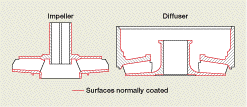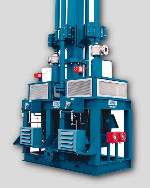lift-pt2-lea.html (Apr-1998)
What’s new in artificial liftPart 2 — Recently introduced innovations in downhole / surface equipment and software for electrical submersible pumping, plus other new artificial-lift-related technologyJames F. Lea, Amoco Production Research, Tulsa, Oklahoma; and Herald W. Winkler, Texas Tech University, Lubbock, Texas
Described here are 20 recently announced developments in downhole equipment, control systems and new applications for electrical submersible pumping (ESP), with all but two of these coming from three principal ESP suppliers. Two other artificial-lift-related technologies introduced include a coiled tubing hanger and an upgraded well analysis program. ELECTRICAL SUBMERSIBLE PUMPING Eighteen ESP innovations offered by three leading manufacturers include six downhole pumps and gas separators, six control systems, three improvements involving cables, two optional ESP applications, and a new catalog. Two other suppliers feature cable testing and a coating to control asphaltene buildup. High-performance rotary gas separator. Electric Submersible Pumps, Inc., Oklahoma City, Oklahoma, has developed a new high-performance rotary gas separator (RGS). Although gas separation efficiencies have been improved by utilizing alternate methods such as reverse flow, rotary gas separators and tapered stage pumps, limitations remain in the gas handling capabilities of pumping systems. The enhanced Type XGC RGS shown schematically in Fig. 1, increases the ability of the ESP to handle a higher percentage of free gas than previous systems. The new gas separators are available in both 400 and 500 series. High-capacity pump for 7-in. casing. Electric Submersible Pumps, Inc. has developed the TE 11000 series pump, reported to have the highest fluid production rate capacity available in the market today for 7-in. OD, 32-ppf casing. This high-efficiency pump, manufactured using precision casting technologies, is available in a compressed type configuration with a recommended operating range of 8,000 to 14,000 bpd. Performance curves are presented in Fig. 2. Water well pumps. Electric Submersible Pumps, Inc. has launched a new water well division to better serve the specific needs of the oilfield in the form of more cost-effective pumping equipment for water supply applications. The developer says needs of the water well industry are different from those of the oil field. And as communities grow and ground water gets deeper and more expensive to produce, ESP technology can be adapted to solve problems such as noise and vandalism associated with surface-driven equipment. New ESP pump designs up to 7,000 gpm (240,000 bpd) are more efficient than ever. Originally designed for harsh oilfield conditions, the pumps fit into slimmer casing and last longer in aggressive water wells. The high-temperature, oil-filled motors are proving more durable in the tougher water well applications, many of which would be considered routine for an oilfield operation. In addition to traditional oilfield 2-pole (3,500-rpm) motors, the supplier offers 4-pole (1,750-rpm) motors and pumps up to 2,500 hp. Power cable with injection tube. REDA, a Camco International Co., Bartlesville, Oklahoma, now offers power cable with injection tubes encased within a common jacket and armor to inject chemicals for well treatments. All of the company’s cables can be manufactured with injection tubes in either round or parallel construction, Fig. 3. Two standard sizes of injection tubes are available in 316L stainless steel, in: 1) 3/8-in. OD, 0.035-in. wall (9.525 ´ 0.889 mm); and 2) 5/16-in. OD, 0.035-in. wall (7.937 ´ 0.889 mm). Working pressure ratings are 3,500 psig (24 MPa) and 4,200 psig (29 MPa) respectively. Additional tube sizes and metallurgies are available on request. Advanced cable testing. REDA has developed an Advanced Cable Testing facility in Lawrence, Kansas, which provides comprehensive testing services for ESP cable. Virtually all well conditions can be duplicated to recommend a cable design that delivers the best performance for specific downhole parameters. Downhole power cable represents a large portion of the cost of an ESP system. By matching cable design with specific well conditions, performance, service life and initial cost can be optimized for each installation. Cables can be tested to 600°F and pressures to 5,000 psi while submerged in crude, brine, diesel fuel and well treating fluids. The most severe combinations of gases found in oil wells can be replicated, including H2S, CO2 and methane in concentrations to 100%. The tests can also be conducted with applied voltage. Quartz downhole gauge. Schlumberger and REDA have joined forces to develop the Pump Watcher Quartz Downhole Gauge, an advanced downhole pressure and temperature monitoring system designed specifically for wells equipped with REDA ESPs, Fig. 4. The high-precision quartz gauge provides continuous pressure and temperature measurements at the pump intake. Data is transmitted on the power cable, eliminating need for an "I"-wire. The telemetry is not affected by electrical noise. The quality, real-time pressure / temperature data can be interpreted by use of off-the-shelf software packages for reservoir characterization and production analyses. Buildup / drawdown tests can be conducted each time the pump is shut down or started. Workover requirements can be determined by assessing wellbore conditions. Inflow Performance Relationship (IPR) can be accurately determined with a multi-rate drawdown test while operating with a variable frequency drive. Installing these tools on multiple ESPs in close proximity can define reservoir connectivity, directional flow patterns and connected porosity through interference testing. The data is conveniently matched by synchronizing the individual internal clocks. Equipment manager. Accurate, timely product data is vital for proper management of submersible pumping system inventories and equipment performance. REDA Equipment Manager (REM) software is an ESP management tool that collects information about pump installations, pulls and follow-up reports. It records information about equipment teardowns (including photographs) to enable analysis of failures and dismantles. It provides reporting and charting tools to facilitate detailed analysis of equipment, wells, fields and regions. It also tracks location of inventory and status of equipment. REM can monitor and report information such as: current inventory levels (active and inactive), well history, performance of a field and / or specific equipment, calculation of "normal" run life (for each well, field, pumping system), and current run life of all downhole equipment. Advanced gas handlers. REDA’s patented Advanced Gas Handler (AGH) has reportedly increased production from 50% to 100% in many gassy wells, while eliminating cycling due to gas locking, Fig. 5. Two new models are now available for 7-in. and larger wells. The two G series systems cover flowrates of 2,000 to 4,000 bpd and 4,000 to 8,000 bpd. Additional models are available for applications from 500 to 10,000 bpd. ESPs are limited in the amount of vapor — the Vapor Liquid Ratio (VLR) — that can be produced with the liquid. Centrifugal pumps will not produce pressure (lift) if the VLR is too great. The new system significantly increases allowable VLR, and can make a well economical to produce by increasing drawdown and extending the field’s economic limit. Interactive product catalog. The first interactive product catalog for ESPs is available from REDA, on diskette or CD-ROM. The user can navigate through the company’s complete product line and compile selections to an electronic order module; this, in turn, can archive a comprehensive listing of equipment for individual wells or complete fields, and the files can be printed or E-mailed. Dynamic pump performance curves can be calculated based on any stage count, unit of measure or operating frequency. Animation modules show operation of different protector types and gas handling vs. gas separation. All screens can be printed as needed. Testing downhole cable. Tejas Logic, Midland, Texas, offers the Series I computer cable test system designed to provide consistent test data for qualifying ESP oilfield cable. Testing implements the API 11S6 standard for new cable acceptance and used cable maintenance, and produces a report that provides test data in a graphical intuitive manner, Fig. 6. Provisions are made to provide specs that may be set to API, IEEE, or customer standards. Test data is stored in a common database format for ease of access by other PC-based programs. The cable is evaluated for both insulation quality and conductor resistance. Insulation is tested by measuring leakage current which flows when voltage is applied to each conductor. Insulation problems are indicated by excessive current leakage or breakdown. Conductor resistance is measured for each phase and calculated in Ohms / 1,000 ft to include temperature effects and cable length, which is compared to ideal cable at a standard temperature. Both variation and deviation from ideal resistance are calculated. The DOS-based software is designed to provide accurate and consistent test results; and demo programs are available for customer evaluation. Specialized coating reduces asphaltene deposition. SR Metal Protection Ltd., Edmonton, Alberta, Canada, has developed a proprietary coating system for reducing asphaltene deposition in ESPs. The coating was initially developed for reducing asphaltenes in flowing wells by coating tubing joints and production tooling used in deposit-affected zones. The coating formulation was modified in late 1995, for application to ESPs. The proprietary coating, called IMPREGLON, is a thin-film organic of the fluoropolymer family. Since the coating has a typical thickness of 0.001-in., it can be applied to almost all wetted surfaces of an ESP stage without causing tolerance problems during assembly, Fig. 7.
The developer, to date, has coated more than 10,000 stages (about 65 pumps) for North American producers and ESP vendors. The coating appears to be successful in fields experiencing asphaltenes; case histories of test trials in fields with severe deposition problems are available. A coating is also being developed for inorganic scale depositions in ESPs and rod pumps. Pump and accessory upgrades / additions. Centrilift, a Baker-Hughes Co., Claremore, Oklahoma, has announced three downhole equipment developments and improvements, as described below. Pump intake for viscous fluids. A patent-pending pump intake for viscous flow applications has been developed. The intake can be used with or without diluent injection and is designed to overcome flow losses that can affect pump capacity. High-capacity rotary gas separator. The Centrilift line of rotary gas separators has been expanded from the 338, 400 and 513 series to include a new 675 series. This addition extends the maximum flow range of the company’s separator line to 25,000 bpd and utilizes a patented, high-efficiency, shrouded rotor design. Mixed flow stage added to 400 series. A new 400-series pump stage, the FC1800 is being introduced. The new, mixed flow design stage incorporates wide flow passageways to resist plugging and improve viscous fluid performance. The stage has a BEP flow of 1,800 bpd at 67% efficiency and 19 ft of head. Offshore pump system. The patent-pending Centrilift HPump Decksaver Plus is a surface system providing for fluid transfer or injection, Fig. 8. It was developed specifically to reduce footprint and weight on offshore applications. The pump system utilizes as little as 10% of the footprint of present conventional systems.
New ESP control systems. Centrilift has recently introduced four systems for more efficiently monitoring and controlling ESPs. Downhole monitoring system. The Centrilift "Tracker" downhole monitor communicates via the ESP power cable. The new system offers the following features:
The new system is presently being field tested; limited production is planned for later this year. Phase-shifting transformer. An innovative phase-shifting transformer design has reduced both size and cost of 12- and 18-pulse Variable Speed Controllers (VSCs). This transformer reduces input harmonics on VSCs. This concept was first applied to conventional ESP drive systems used outdoors. This has been extended for use indoors, with development of phase-shifting transformers packaged with the same height and depth as the variable speed drives. This allows for an MCC-type lineup in a control room. Enhanced serial communications. Centrilift has developed the "Integrated Communications Module" (ICM) for use with the popular Electrospeed ICS Variable Speed Controller (VSC). The ICM provides enhanced serial communications capabilities; and all operator interface functions are accessible via a host computer. The ICM provides both RS-232 and RS-485 serial ports with standard Modbus protocol. Self-contained variable speed controller module. The company’s self-contained A60-rated ICS Variable Speed Controller (VSC) module complete with step-up transformer is now available for use in Zone 1 or 2 offshore hazardous locations (US: Class 1, Divisions 1 & 2). The VSC module has these features: a self-contained purge, pressurization, fire and gas system; marine-rated HVAC system; it is certified to DNV or Lloyds requirements; and it uses the ICM serial communication interface with the platform control system. Heater cable for permafrost locations. Centrilift’s Centriline heater cable economically applies heat downhole in the permafrost zone of ESP wells in Arctic locations, to control or eliminate formation of hydrates and prevent freezing, Fig. 9. By applying heat to the tubing string with the new cable system, the operator can adjust temperature levels for varying well conditions. The new system is the first downhole cable heating system with these features: 1) it is available in lengths up to 10,000 ft or more; 2) it withstands the rigorous conditions of oilfield installation and operation; and 3) it is designed "from the conductor out" for maximum efficiency. Further, the system is easy to install and service in the oil patch, including splicing and repair; and it provides lead encapsulation for cable protection in H2S environments. OTHER NEW DEVELOPMENTS In other recent advances related to artificial lift, two suppliers offer a new high-pressure coiled tubing hanger and updated well analysis software for estimating formation production capacity based on fluid level measurements. High-pressure coiled tubing hanger. The Piper Oilfield Products (Oklahoma City, Oklahoma) HCT hanger consists of two main components; a 10,000-psi WP stripper blowout preventer, and a hydraulically actuated slip assembly, Fig. 10. The BOP is capable of closing around any size tubing. It uses a two-piece packer arrangement molded out of nitrile rubber and bonded to metal retainer rings. The inner packer has a large amount of feed-able rubber that can be used for stripping operations, and still be used as the annular pack-off after hanging the tubing. Once packed off around the tubing, the stripper BOP uses wellbore pressure to assist in closure so that if there is an increase in bore pressure, the packer will seal more tightly against the tubing. This packer design eliminates need for a different packer for each size of tubing. Well analysis software. Echometer Co., Wichita Falls, Texas, is offering a new Windows software program AWP98 for analyzing well performance. This is a major upgrade for Windows from a previous AWP DOS version. The program analyzes well performance for beam pumping, PCP, and ESP installations from acoustic liquid level depth measurements using strip chart recorders, Fig. 11. The operator inputs the number of tubing collars from surface to liquid level that are recorded on the strip chart, in addition to casing pressure, casing pressure build-up rate and other well parameters. The program then calculates bottomhole pressure. This data is then analyzed to determine the well’s producing rate efficiency. If the well-test data is entered, the program can calculate the maximum production available from the well. The analysis is presented as a schematic drawing of the well with liquid level depth,
pressures and well performance displayed. Previous well file data including pump depth,
formation depth and average joint length can be recalled and processed with recent liquid
level measurement data; all of this information can be saved and printed. The AWP98 program is
available free on disk from the vendor, or it can be downloaded from the web.
The authors
Copyright © 1999 World
Oil |
- Applying ultra-deep LWD resistivity technology successfully in a SAGD operation (May 2019)
- Adoption of wireless intelligent completions advances (May 2019)
- Majors double down as takeaway crunch eases (April 2019)
- What’s new in well logging and formation evaluation (April 2019)
- Qualification of a 20,000-psi subsea BOP: A collaborative approach (February 2019)
- ConocoPhillips’ Greg Leveille sees rapid trajectory of technical advancement continuing (February 2019)



 James
F. Lea is a special research associate in the Production Mechanics Group of Amoco
Production Research Co. in Tulsa, Oklahoma. He is a member of SPE and ASME.
James
F. Lea is a special research associate in the Production Mechanics Group of Amoco
Production Research Co. in Tulsa, Oklahoma. He is a member of SPE and ASME. Herald
W. Winkler is former chairman, now professor emeritus and research associate, in
the Department of Petroleum Engineering at Texas Tech University in Lubbock, Texas. He is
presently working as a consultant in artificial lift, specializing in gas lift.
Herald
W. Winkler is former chairman, now professor emeritus and research associate, in
the Department of Petroleum Engineering at Texas Tech University in Lubbock, Texas. He is
presently working as a consultant in artificial lift, specializing in gas lift.
